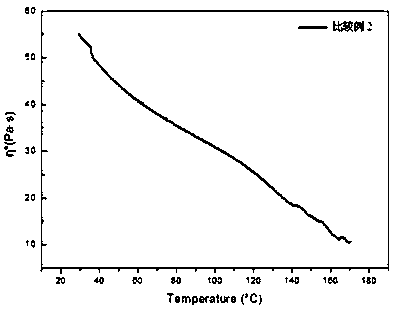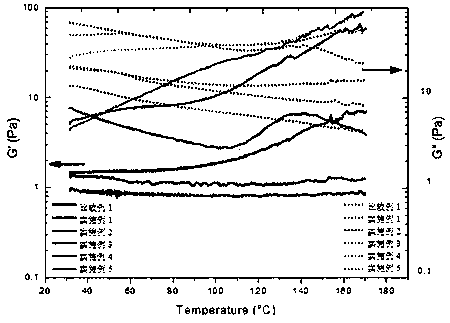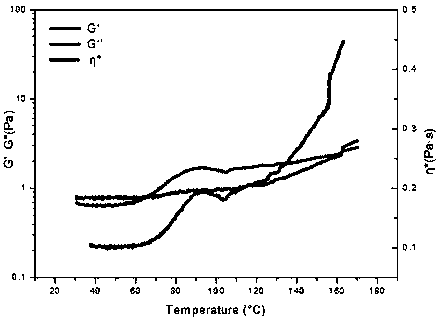A method for in-situ preparation of nano-silica/hydroxyl-terminated polydimethylsiloxane hybrid material
A technology of hydroxyl-terminated polydimethylsiloxane and nano-silicon dioxide is applied in the field of in-situ preparation of nano-silica/hydroxyl-terminated polydimethylsiloxane hybrid materials, which can solve the problems of agglomeration and polymer rheology. Poor, large specific surface area of nano-silica, etc., to achieve the effect of reducing viscosity
- Summary
- Abstract
- Description
- Claims
- Application Information
AI Technical Summary
Problems solved by technology
Method used
Image
Examples
Embodiment 1
[0027] A method for preparing nano-silica / hydroxyl-terminated polydimethylsiloxane hybrid materials in situ, comprising the following steps: adding DMC and tetramethylammonium hydroxide to a three-necked flask equipped with a reflux condensation device, Warm up to 100°C under stirring, and stir at constant temperature for 50 minutes to make DMC ring-open and prepolymerization; then add nano-silica, stir at 100°C for 60 minutes, no distillate; Under the condition of MPa~-0.04 MPa, stir at a constant temperature of 100°C until no fraction distills out; cool to room temperature to obtain it; wherein, the mass ratio of DMC ring body, tetramethylammonium hydroxide and nano silicon dioxide is 100:2 ×10 -4 :2.
Embodiment 2
[0029] A method for preparing nano-silica / hydroxyl-terminated polydimethylsiloxane hybrid materials in situ, comprising the following steps: adding DMC and tetramethylammonium hydroxide to a three-necked flask equipped with a reflux condensation device, Heat up to 105°C under stirring, and keep stirring at constant temperature for 50 minutes to make DMC ring-opening and prepolymerization; then add nano-silica, stir at 100°C for 60 minutes, no distillate; Under the condition of MPa~-0.04 MPa, stir at a constant temperature of 105°C until no fraction distills out; cool to room temperature, and obtain it; wherein, the mass ratio of DMC monomer, tetramethylammonium hydroxide and nano-silicon dioxide is 100:2 ×10 -4 :4.
Embodiment 3
[0031] A method for preparing nano-silica / hydroxyl-terminated polydimethylsiloxane hybrid materials in situ, comprising the following steps: adding DMC and tetramethylammonium hydroxide to a three-necked flask equipped with a reflux condensation device, Warm up to 100°C under stirring, and stir at constant temperature for 50 minutes to make DMC ring-open and prepolymerization; then add nano-silica, stir at 100°C for 60 minutes, no distillate; Under the condition of MPa~-0.04 MPa, stir at a constant temperature of 100°C until no fraction distills out; cool to room temperature to obtain it; wherein, the mass ratio of DMC ring body, tetramethylammonium hydroxide and nano silicon dioxide is 100:2 ×10 -4 :6.
PUM
| Property | Measurement | Unit |
|---|---|---|
| particle diameter | aaaaa | aaaaa |
Abstract
Description
Claims
Application Information
 Login to View More
Login to View More - R&D
- Intellectual Property
- Life Sciences
- Materials
- Tech Scout
- Unparalleled Data Quality
- Higher Quality Content
- 60% Fewer Hallucinations
Browse by: Latest US Patents, China's latest patents, Technical Efficacy Thesaurus, Application Domain, Technology Topic, Popular Technical Reports.
© 2025 PatSnap. All rights reserved.Legal|Privacy policy|Modern Slavery Act Transparency Statement|Sitemap|About US| Contact US: help@patsnap.com



